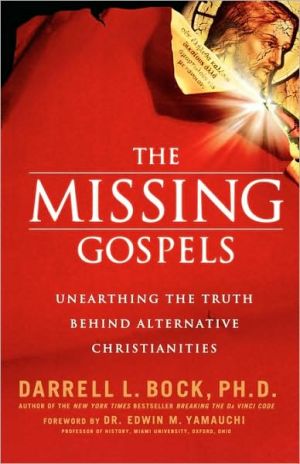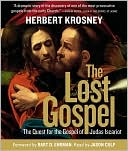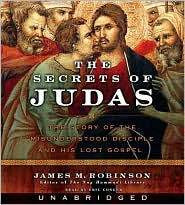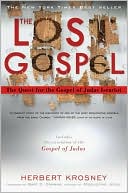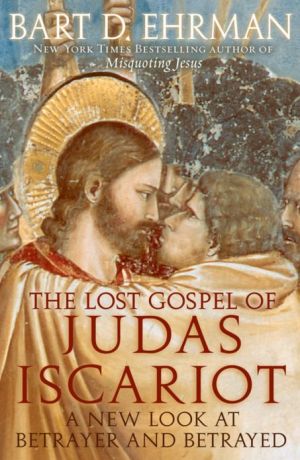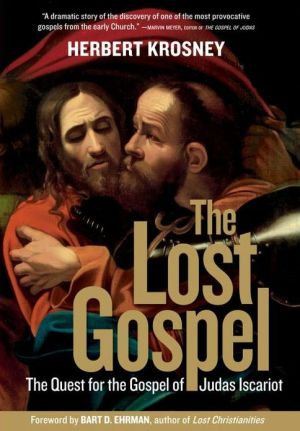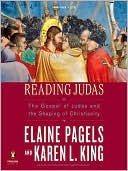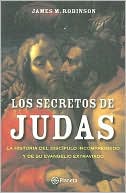The Missing Gospels: Unearthing the Truth Behind Alternative Christianities
IS JESUS WHO YOU THINK HE IS?\ Perhaps you've heard the recent buzz about "alternative Christianities" and "new gospels." Speculations have shown up in magazines, documentaries, popular fiction, and even on the big screen. Much of the controversy stems from a library of ancient texts found at Nag Hammadi, Egypt. Now revolutionary questions about the Christian faith are being raised as a result of these findings:\ \ Is Jesus truly a divine Savior or just a teacher of wisdom?\ Is orthodoxy a...
Search in google:
What others are saying about The Missing Gospels"Darrell Bock has written a timely and valuable study for anyone curious about the question of lost or missing gospels. The Missing Gospels is a breath of sanity!"-Philip Jenkins, Professor of History and Religious Studies, Penn State"Those who don't want their prejudices disturbed will want to avoid this book. Those with an open mind and readiness to learn from scholarship . . . read with profit."-Larry Hurtado, Professor of New Testament Language, Literature, and Theology, University of Edinburgh, Scotland"Darrell Bock patiently, and accessibly, sifts through all the relevant issues and offers much-needed guidance to those who want to discern fact from fiction. If you read only one book on this issue, this is it!"-Andreas J. Kostenberger, PhD, Professor of New Testament and Greek, Southeastern Baptist Theological Seminary"The Missing Gospels is a unique resource for those who wish to respond to the 'new school' with accuracy and confidence."-Frederica Mathewes-Green, National Public Radio's Morning Edition Commentator"A necessary book that corrects many still fashionable but even more questionable hypotheses about the origin of the Gospels, the Nag Hammadi texts, and the development of Christian theology in the first two centuries AD."-Prof. Dr. Martin Hengel, Professor Emeritus of New Testament and Ancient Judaism, University of Tubingen, Germany______________________________For a brief overview from Dr. Bock on the contents of the Gospel of Judas along with other materials, please visit www.thomasnelson.com/missinggospels. Publishers Weekly The wild success of Dan Brown's The Da Vinci Code has spawned a thriving cottage industry of both supporters and critics. One of Brown's more controversial assertions is that the emergence of Christian orthodoxy was based not on its merit but on the politics of the winning side. Here, Bock sums up the evangelical perspective as he challenges the idea that orthodoxy "emerged" at all. Rather, he argues, it survived its many challenges in the early centuries of the Christian church because it best reflected the thoughts and teachings of Jesus and the apostles. The author, who teaches New Testament at Dallas Theological Seminary, considers the idea that Christianity needs to be "reimagined"-reformed in the image of recent archeological and literary discoveries-to be an ill-advised attempt to rewrite history. He takes on those scholars who want to reinterpret Christianity in light of early Gnostic teachings that denied the oneness of the Father and the Son and spiritualized the gospel stories into myths. Bock recognizes this is pretty sophisticated stuff, and offers the reader a helpful chapter outlining times, names and ideas, providing a useful framework for the rest of his book. While not conclusively proving his thesis, Bock does provide a lively and readable survey of competing beliefs in Christianity's earliest days. (Aug. 8) Copyright 2006 Reed Business Information.
The Missing Gospels\ Unearthing the Truth Behind Alternative Christianities \ \ By Darrell L. Bock \ Nelson Books\ Copyright © 2007 Darrell L. Bock, PhD\ All right reserved.\ ISBN: 978-0-7852-8906-7 \ \ \ \ Chapter One\ Making a Scorecard: The Periods and Players of Early Christianity \ This chapter assumes you have little or no knowledge of early Christianity, especially the time period of the second and third centuries. Here, I introduce the three periods of early Christianity, noting the Jewish origins from which Christianity arose-the apostolic period, the period of the apostolic fathers and the rise of alternative texts, and the period of the apologists and more alternatives.\ Christianity and the Promise of Israel's God\ The starting point for early Christianity was as a Jewish movement that appealed to the promise of God in the Scripture of Israel. In the beginning, there were Jesus and the apostles, claiming Jesus Christ fulfilled God's promise.\ All the writings we have from the works of the first century to the works of the apologists show an intense concern, whether positive or negative, with issues raised by the Scripture of the Jews (Mitros 1968, 448-50). The apologists were defenders of Christianity against Greco-Roman religion, Judaism, and threatening movements that also claimed the name of Christ. Their work emerged in the mid-second century and continued to discuss how Jesus fulfilled the original Jewish promise.\ Scholars debate when the promise was first uttered. Was it found in Genesis 3:15 when God said the seed of man would crush the head of the serpent? Was it in Genesis 12:1-3, in His promise that the seed of Abraham would be a source of blessing to all the world? Was it in texts like Isaiah 9, where a messianic-delivering figure is described? Was it in Daniel 7:13-14, where the Son of man rides the clouds with divine authority? Was it in a composite of all of these? In the first century, was there one unified expectation, or was there a promise described in diverse ways with diverse forms of expectation in Judaism?\ For us, the key fact is that in the first century, most Jews had some form of hope that one day God would send a deliverer for His people and for the world, even though these Jews saw the fulfillment of that promise in differing detail or highlighted in different texts. That large parts of Israel's faith were driven by such a promise in the first century is one of the few things about which virtually all scholars agree. This root in scriptural hope is the seed of Christian faith. God would send a deliverer one day according to the promise of the Hebrew Scripture.\ Much of Christianity in the first two centuries claims that Jesus was and is the fulfillment of that promise. This root in the Scripture of Israel-its promise and its portrait of God-is part of what became a source of contention when Marcion in the mid-second century rejected the God of Israel as identified with the God that Christians worship. It also became a point of contention when others calling themselves Christians-but whom many scholars today call Gnostics-suggested that the God who created the Earth and the true transcendent God were not the same figure. But we are jumping ahead in our story.\ As we shall see in Chapter 4, some today argue that the roots of Christianity are not found in this promise of deliverance because Jesus was merely about wisdom and pointing to a way of life pleasing to God. It was the later church, some say-not Jesus-that transformed this wise teacher into a figure of worship, promise, and divinity. Strangely enough, in many ways, the core of the modern debate about Christianity is centered on how connected the earliest Christianity was to the theology of Judaism, God's promise, and Israel's portrait of God. We shall keep an eye on this connection since it is a central piece to our puzzle.\ The Periods of Early Christianity: Putting the Newly Discovered Gospels in Context\ These periods are standard in early church history, but the new school claims these categories obscure the real diversity of the earliest forms of Christianity. The claim is, if you make the rules and define the categories the way you want, you get to win the game before it starts. Because the issue of Christianity's roots is in question, you should note that the descriptions presented here are not claims that these divisions reflect the full picture of what was taking place in the first two centuries of Christianity. These descriptions can obscure the diversity that was at work in the early centuries of Christianity. The divisions used here merely provide a time structure for these lesser-known figures and movements of early Christian history, showing where and when people fit in our historical tour.\ Period 1: Jesus and the Apostolic Period\ This first period covers roughly the last seventy years of the first century. It is generally acknowledged that Jesus ministered in the late twenties or early thirties of the first century. Those who were closest to Him, the apostles, ministered throughout the first century. That period is called the apostolic era. Although scholars debate the exact dates of the composition of the four Gospels and those of the newly discovered gospels, there is widespread acceptance that the gospels of Matthew, Mark, Luke, and John fit into this period with John, written in the nineties, being the last of the four.\ We have little explicit evidence for alternative groups from this early period. We lack materials directly from these groups, with the possible exception of the Gospel of Thomas, but we have hints of opposition and dissent from the traditional materials of the first century. To reconstruct the dissent, let's look at a few brief remarks in those traditional texts.\ One alleged leader of an alternative movement from this period is Simon Magus. The church fathers I shall mention shortly tend to lay the entire blame at his feet for the movements that they contest. Simon Magus is noted in Acts 8, where he is described as a magician. Acts has no remarks about him founding a heretical movement. The source of this claim is unknown, and the credibility of the claim that heresy originated with Simon is very problematic (Yamauchi 1983, 60). Beyschlag's detailed study (1974, 218) places the rise of this tradition about Simon as the father of heresy in the first half of the second century.\ Another set of opponents surfaces in 1 Timothy 1:20. Here Hymenaeus and Alexander "shipwrecked" their faith. In 1 Timothy 1:3-7, they are included in a discussion of people teaching a different doctrine that includes myths and endless genealogies, promoting speculation rather than faith. First Timothy 4:1-3 warns of those in the last days who will teach against marriage. Some later Gnostic movements did teach against marriage, but so did some traditional movements, reflecting a concern by some with spiritual interests about sexuality. In 2 Timothy 2:17-18, Hymenaeus is mentioned again with Philetus as teaching that the decisive resurrection of believers has already occurred. What these epistles describe as a different doctrine many regard as potentially similar to things that appear in even more detail in some of the newly discovered works that have been called Gnostic. This is all we can say from the earliest material, which is not very much (Hengel 1997, 190-92). In other words, these remarks do not evidence the presence of Gnosticism, but the presence of elements that showed up later in Gnosticism. At best, they reflect what has been called incipient Gnosticism.\ What do appear in our earliest sources are ideas that the writers of the Epistles challenged rather than named. For example, 1 Corinthians 15 (written mid-fifties) indicates that some denied a resurrection from the dead for the body. Scholars debate whether the views Paul challenged were a reflection of some type of Gnostic denial of the resurrection of the flesh or simply a reflection of the general Greco-Roman belief that denied a physical life after death. First John (written early nineties) shows that some did not believe Jesus came in the flesh. People who divided between a sent Christ and a physical Jesus are called docetists because they believed that Jesus only "appeared" to be in the flesh.\ Passages like these let us know that there was diversity in early belief. The questions they raise include these: How was this diversity perceived? Did diversity reflect competing orthodoxies, mere alternatives, or the naming of the presence of a heretical view? And on what basis was such a judgment to be made? Was it on politically competing points of view where one side simply won? Or were there appeals to teaching that could credibly claim to have association with Jesus or the apostles? These questions will drive our tour. Where the newly discovered gospels fit. Dating is one key issue tied to the newly discovered gospels. Most of the gospels we have recently discovered are dated in the second or third century (see suggested dates in the following: Rebell 1992; Ehrman 2003; Klauck 2003; Lapham 2003; White 2004). But a few, such as the Gospel of Thomas, are sometimes placed earlier, in the apostolic period or with roots that may go back to that period. This is why some have talked about the importance of this gospel. For example, White (2004, 304) argues that the earliest layers of Thomas date from 60-70 with roots in some material that goes back to Jesus, while later layers are from the late first or early second century. Ehrman (2003, xii) places it in the early second century but with parts that may go back to Jesus. On the other hand, Klauck (2003, 108) dates the work outside this period, between 120 and 140. Snodgrass (1989-90) argues that there is much evidence of dependence of Thomas on Luke and the synoptic tradition, for several of Thomas's sayings appeal to rarely used words and editorial tendencies in these other works (sayings 10, 16, 31, 33, 39, 47, 53, 65-66, 72, 76b, 79, 104). Perrin (2002) sees a relationship between Tatian's Diatessaron from circa AD 170 and Thomas. This suggests the gospel has roots in a late tradition, not an early one. Hedrick (1989-90) has shown it is likely that some material for Thomas comes from sources other than the synoptic Gospels, so the material has to be assessed one saying at a time. In sum, it is possible that a portion of the material in Thomas reflects tradition circulating among the churches that could belong to this early period, but these must be examined on a saying-by-saying basis (Klauck 2003, 108). Nevertheless, the gospel itself is likely later rather than earlier.\ The sayings that parallel those in Matthew, Mark, and Luke help us see the later date for Thomas. Klauck (2003, 108) notes that roughly 50 percent of Thomas has no contact with anything expressed in the New Testament. In his view, the other half is split between texts that resemble things in Matthew, Mark, and Luke and independent sayings that claim to be revelatory and have a "more strongly gnostic character" (Klauck 2003, 108). The debate about Thomas includes what and how much of this material goes back to Jesus and how much of it is a reflection of later Gnostic concerns. Most of Thomas does not go back to Jesus, but a few pieces could.\ The debate has a few other keys. So we cover the age of Gnosticism in Chapter 3. Thomas and the Jesus tradition receive attention in Chapter 4. Making headway on these topics requires treating another issue, historical method and judgment, also considered in Chapter 4.\ A review of the newly discovered material, including the missing gospels, indicates that the bulk of it comes from the second and third centuries. On this, almost all scholars are agreed. Three corollaries tied to this fact are important:\ 1. Many of these works reflect the period in which they were written and have no coherent links to the period to which their title points. The issues these works discuss appear later in the history of the church and not in the earliest period. This is one way we can see that these works are later than the earliest period. For example, the Gospel of Peter is not from Peter nor does it give teaching preserved by those familiar with his teaching; it is simply a name given to lend authority to a work written much later. Almost every scholar agrees with this view of this gospel. This situation stands in contrast to Mark or Luke in that neither writer of these gospels was an apostle, yet many accept that Mark and Luke had access to the apostles and were aware of what they taught. For Mark, the contact point was Peter (Taylor 1966, 1-8, 26), while Luke likely had contact with several of the apostles and traveled with Paul (Fitzmyer 1981, 40). Roots of portions of other gospels, like Thomas, are more debated and difficult to assess. A question exists whether Thomas has early roots.\ Newly discovered but later works still have value for us as historical documents. They describe what some people associating themselves with Christianity believed at the time these documents circulated, even though these texts have little value in illuminating the earliest Christianity. Nag Hammadi is an important find even if it contains documents whose dates of composition are post-first century. We learn what was going on in this later period from people who held these alternative views. Diversity of views existed among groups associating themselves with Christianity in the apostolic period as the disputes already noted in 1 and 2 Timothy show. The debates are about what those views were, how widespread they were, and whether these alternatives were regarded as orthodox or not.\ 2. We possess only a portion of the writings that existed in the first century. The nature of all historical records is that the surviving collection is partial, and this is especially true of ancient history. The problem is what to make of this lack of evidence. This gap creates room for debate and contributes to the existence of various modern views on the question.\ 3. This leads to the subtlety of a third corollary sometimes offered for the late nature of these materials in the extant manuscript record-the claims that these texts were suppressed and/or destroyed. We lack such texts because the other side removed them from the scene long ago, so the evidence we have does not really reflect what was. Now we know such suppression and destruction took place in the third century and beyond. We also know it happened with all kinds of Christian texts during the persecutions of Christians in the earliest centuries. Nevertheless, this position is really an argument from silence. The claim is that if we had a fully documented record, surely early or more materials like these alternative gospels would exist. There is no way to evaluate such a hypothetical claim. Proponents of this scenario hold that it is remarkable anything like Thomas has survived while they also acknowledge it is unlikely that this work comes from the apostle Thomas.\ But what about a couple of other options? Might we lack such materials because they were simply lost, as most ancient works are, rather than suppressed? Or might we have no clear early record of such movements because they did not yet exist? The problem is that any of these three scenarios (loss by suppression, simple loss, or absence because such movements did not yet exist) can explain the evidence we have. The presence of various potentially plausible options also leads to the debate. An overview of the issues surrounding the missing gospels is necessary before looking at the gospels themselves so we can understand where they fit and why there is controversy about them.\ (Continues...)\ \ \ \ \ Excerpted from The Missing Gospels by Darrell L. Bock Copyright © 2007 by Darrell L. Bock, PhD. Excerpted by permission.\ All rights reserved. No part of this excerpt may be reproduced or reprinted without permission in writing from the publisher.\ Excerpts are provided by Dial-A-Book Inc. solely for the personal use of visitors to this web site. \ \
Introduction : do new discoveries mean Christianity needs a makeover?1Make a scorecard : the periods and players of early Christianity12Discussion of a key alternative view : about gnosticism and its definition153Dating the origin of gnosticism224Early Christianity's diversity and historical judgments325The claims of Walter Bauer and the roots of the new school446The nature of God and creation, part 1567The nature of God and creation, part 2838Jesus : divine and/or human? : part 1979Jesus : divine and/or human? : part 211510The nature of humanity's redemption : spiritual or also physical? : part 113111The nature of humanity's redemption : spiritual or also physical? : part 214712Jesus' death : knowledge, sin, and salvation, part 116513Jesus' death : knowledge, sin, and salvation, part 218314Conclusion : the new school, the missing gospels, alternative Christianities, and orthodoxy200App. 1List of extant texts beyond the four gospels215App. 2List of key texts in the apostolic fathers220
\ From Barnes & NobleIn this accessible book, Breaking the Da Vinci Code author Darrell Bock examines missing, suppressed, and recovered secret gospels and explains their real significance to the New Testament story. A Christian view of a controversial subject.\ \ \ \ \ Publishers WeeklyThe wild success of Dan Brown's The Da Vinci Code has spawned a thriving cottage industry of both supporters and critics. One of Brown's more controversial assertions is that the emergence of Christian orthodoxy was based not on its merit but on the politics of the winning side. Here, Bock sums up the evangelical perspective as he challenges the idea that orthodoxy "emerged" at all. Rather, he argues, it survived its many challenges in the early centuries of the Christian church because it best reflected the thoughts and teachings of Jesus and the apostles. The author, who teaches New Testament at Dallas Theological Seminary, considers the idea that Christianity needs to be "reimagined"-reformed in the image of recent archeological and literary discoveries-to be an ill-advised attempt to rewrite history. He takes on those scholars who want to reinterpret Christianity in light of early Gnostic teachings that denied the oneness of the Father and the Son and spiritualized the gospel stories into myths. Bock recognizes this is pretty sophisticated stuff, and offers the reader a helpful chapter outlining times, names and ideas, providing a useful framework for the rest of his book. While not conclusively proving his thesis, Bock does provide a lively and readable survey of competing beliefs in Christianity's earliest days. (Aug. 8) Copyright 2006 Reed Business Information.\ \
